Saltwater Fish Details
Quick Links
Almaco Jack | American Shad | Atlantic Sharpnose Shark | Atlantic Croaker | Banded Rudderfish | Bank Sea Bass | Black Grouper | Black Sea Bass | Black Drum | Blackfin Snapper | Blue Runner | Blue Marlin | Bluefish | Bonefish | Bonnethead Shark | Cero | Cobia | Common Snook | Crevalle Jack | Cubera Snapper | Dog Snapper | Dolphin | Fantail Mullet | Fat Snook | Florida Pompano | Gag Grouper | Goliath Grouper | Gray Snapper | Greater Amberjack | Gulf Flounder | King Mackerel | Ladyfish | Lane Snapper | Lesser Amberjack | Longbill Spearfish | Mahogany Snapper | Mutton Snapper | Nassau Grouper | Palometa | Permit | Queen Snapper | Red Drum | Red Grouper | Red Snapper | Rock Sea Bass | Sailfish | Sand Seatrout | Sandbar Shark | Scalloped Hammerhead | Scamp | Schoolmaster | Sheepshead | Shortfin Mako | Silk Snapper | Silver Seatrout | Silver Perch | Spanish Mackerel | Spotted Seatrout | Striped (Black) Mullet | Swordfish | Swordspine Snook | Tarpon Snook | Tarpon | Vermillion Snapper | Weakfish | White Marlin | White Grunt | Yellowfin Grouper | Yellowmouth Grouper | Yellowtail Snapper
Common Snook

Distict black lateral line; high, divided dorsal fin; sloping forehead; large mouth, protruding lower jaw; grows much larger than other snooks; pelvic fin yellow.
Where Found:
From central Florida south, usually INSHORE in coastal and brackish waters, along mangrove shorelines, seawalls, and bridges; also on reefs and pilings NEARSHORE.
Size:
Most catches 5 to 8 pounds.
Remarks:
Spawns primarily in summer; cannot tolerate water temperatures below 60° F; can tolerate wholly fresh or saltwater; schools along shore and in passes during spawning season; feeds on fish and larger crustaceans.
Crevalle Jack

Color bluish-green to greenish-gold back and silvery or yellowish belly; soft dorsal and anal fins almost identical in size; prominent black spot on operculum (gill cover); black spot at the base of each pectoral fin; no scales on throat.
Where Found:
Common in both INSHORE waters and the open sea.
Size:
Usually 3 to 5 pounds.
Remarks:
Tolerates a wide range of salinities; schools corner a school of baitfish at the surface and feed with commotion that can be seen for great distances; feeds mainly on small fish; peak spawning occurs OFFSHORE from March through September.
Cubera Snapper
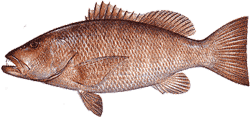
Color dark brown or gray, may have a reddish tinge; broad-based triangular tooth patch on roof of mouth without posterior extension; despite its specific name, which translates to “blue-fin”, the fin have only a slight tinge of blue; canine teeth on both jaws very strong; one pair of canines enlarged and visible even when mouth is closed.
Where Found:
Juveniles INSHORE in grassbeds; adults OFFSHORE or NEARSHORE over wrecks, reefs, and ledges.
Size:
Common to 40 pounds.
Remarks:
The largest of the snappers, ranging to 125 pounds; not common anywhere in its range; feeds on fish and larger crustaceans; in the Keys, spawns during later summer.
Dog Snapper

Color brown with a bronze tinge, lighter on sides; canine teeth very sharp, one pair notable enlarged, visible even when mouth is closed; in adults, pale triangle and a light blue interruped line below the eye; no dark spot on body under dorsal fin.
Where Found:
Large adults OFFSHORE over coral and rocky reefs; juveniles associated with estuaries.
Size:
Large snapper; attaing 30 pounds.
Remarks:
Spawns from spring through fall; known as night feeder; taking fish, mollusks, and crustaceans.
Dolphin
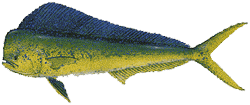
Color brown with a bronze tinge, lighter on sides; canine teeth very sharp, one pair notable enlarged, visible even when mouth is closed; in adults, pale triangle and a light blue interruped line below the eye; no dark spot on body under dorsal fin.
Where Found:
OFFSHORE in warm waters.
Size:
Common to 30 pounds.
Remarks:
One of the fastest-growing fish, thought to live no more than 5 years; swimming speed estimated at 50 knots; spawns in warm oceanic currents throughout much of the year; young found in sargassum weed; feeds on flying fish and squid.
Fantail Mullet
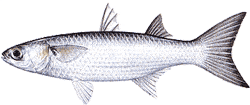
Color olive green with blue tints on back, shading to silvery sides, white below; anal and pelvic fins yellowish; dark blotch at base of pectoral fin; inverted V-shaped mouth; insertion of second dorsal fin over that of the anal fin.
Where Found:
INSHORE, occurring along beaches in the fall.
Size:
Small mullet, less than 1 pound.
Remarks:
Spawns in NEARSHORE or possibly INSHORE waters during spring and summer; juveniles occur INSHORE; feeds on algae, small crustaceans, detritus.
Fat Snook
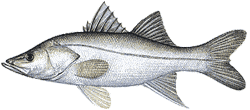
Deeper body than other snooks; color yellow-brown to green-brown above, silvery on sides; black lateral line extends onto tail; mouth reaches to or beyond center of eye; usually no dusky outer edge on pelvic fin, as in other snooks; smallest scales of all snook.
Where Found:
INSHORE species found in mangrove habitiat; found commonly in fresh water; occurs more in interior waters ( as opposed to estuarine waters ) than other snook.
Size:
A small species, rarely more than 20 inches.
Remarks:
Usually found in fresh water; mangrove shorelines serve as nursery grounds for young.
Florida Pompano
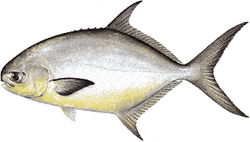
Greenish gray on back, shading to silvery sides; fish in dark waters showing gold on throat, pelvic, and anal fins; deep flattened body with small mouth; no scutes; 22 to 27 soft dorsal rays; 20 to 23 soft anal rays; origin of anal fin slightly behind origin of second dorsal.
Where Found:
INSHORE and NEARSHORE waters, especially along sandy beaches, along oyster bars, and over grassbeds, often in turbid water; may be found in water as deep as 130 feet.
Size:
Usually less than 3 pounds.
Remarks:
Spawns OFFSHORE between March and September; feeds on mollusks and crustaceans, especially sand fleas; local movements are influenced by the tide, and seasonal movements are influenced by temperature.
Gag Grouper

Brownish gray in color with dark worm-like markings on sides; strong serrated spur at bottom margin of preopercle, less noticeable in large specimens; fins dark, with anal and caudal having white margin. Often confused with Black Grouper; most noticeable differences are brassy spots on Black Grouper; tail of Gag is slightly concave, black is square; Gag has white margin on anal and caudal fins, black does not; under 10 pounds, Gag’s spur on preopercle is distincive, where black is gently rounded.
Where Found:
Adults OFFSHORE over rocks and reefs; juveniles occur in seagrass beds INSHORE.
Size:
Common to 25 pounds.
Remarks:
Forms spawning aggregations in water no shallower than 120 feet in Middle Grounds area. January through March; current research to identify similar aggregations off the Atlantic coast is on going. Young Gags are predominantly female, transforming into males as they grow larger; feeds on fish and squid.
Goliath Grouper
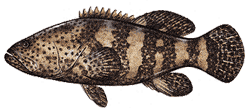
Head and fins covered with small black spots; irregular dark vertical bars present on the sides of body; pectoral and caudal fins rounded; first dorsal fin shorted than and not separated from second dorsal; adults hugh, upto 800 pounds; eyes small.
Where Found:
NEARSHORE around docks, in deep holes, and on ledges; young often occur in estuaries, especially around oyster bars; more abundant in southern Florida than in northern waters.
Size:
Largest of the groupers.
Remarks:
Spawns over summer months; lifespan of 30 to 50 years; feeds on crustaceans and fish. NOTE: Jewfish are totally protected from harvest in Florida waters.
Gray Snapper
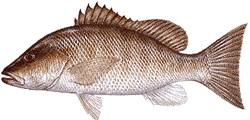
Color dark brown or gray with reddish or orange spots in rows along the sides; dark horizontal band from snout through eye (young only); two conspicuous canine teeth at front of upper jaw; dorsal fins have dark or reddish borders; no dark spot on side underneath dorsal fin.
Where Found:
Juveniles INSHORE in tidal creeks, mangroves, and grass beds; adults generally NEARSHORE or OFFSHORE on coral or rocky reefs.
Size:
OFFSHORE catches common 8 to 10 pounds.
Remarks:
Spawns June through August; feeds on crustaceans and small fish. Also known as “Mangrove Snapper”.
Greater Amberjack
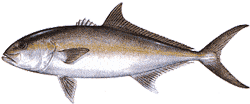
Dark stripe (variably present) extends from nose to in front of dorsal fin and “lights up” when fish is in feeding mode; no scutes; soft dorsal base less than twice the length of the anal fin base.
Where Found:
OFFSHORE species associated with rocky reefs, debris, and wrecks, typically in 60-240 feet of water; sometimes caught NEARSHORE in south Florida; juveniles associate with floating objects and may occur in water less than 30 feet deep.
Size:
Common to 40 pounds.
Remarks:
Largest of the jacks; thought to spawn OFFSHORE throughout much of the year; feeds on squid, fish, and crustaceans.
Gulf Flounder
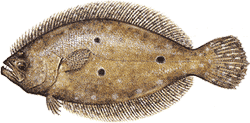
Body color brown, its shade depending on color bottom, with numerous spots and blotches; 3 prominent eye-like spots forming a triangle; one spot on lateral line, one above, one below; numerous white spots scattered over body and fins; strong canine-like teeth; caudal fin in shape of wedge, its tip in the middle.
Where Found:
INSHORE on sandy or mud bottoms, often ranging into title creeks; occasionally caught on NEARSHORE rocky reefs.
Size:
Common to 2 pounds, generally smaller than southern flounder.
Remarks:
Hatches into usual fish form, but right eye migrates over to left side early in life; a bottom dweller; thought to spawn offshore; feeds on crustaceans and small fish.
King Mackerel

Color of black iridescent bluish green, sides silvery; streamlined body with tapered head; no black pigment on front of the first dorsal fin; lateral line starts high and drops sharply below the second dorsal; young fish often have yellowish spots like those of Spanish mackerel.
Where Found:
| NEARSHORE and OFFSHORE; occasionally taken from piers running into deep water. |
Size:
Common to 20 pounds.
Remarks:
Schooling fish that migrates from south Florida waters in winter to more northerly waters in spring; Gulf population thought to be separate from Atlantic population, with considerable mixing in winter from Cape Canaveral past Key West; spawns in midsummer OFFSHORE; feeds on fish and squid.
LadyFish

Terminal mouth; slender body; small scales; last dorsal ray not elongated; head small and pointed.
Where Found:
| INSHORE fish, in bays and estuaries; occasionally enters freshwater, occuring in tidal pools and canals; often forms large schools and harasses bait at the surface. |
Size:
2 to 3 pounds.
Remarks:
Known to spawn OFFSHORE; ribbon-like larvae very similar to Albula and Egalops, peaking in fall; adults feed predominantly on fish and crustaceans; leaps when hooked.
Lane Snapper

Color silvery-pink to reddish with short, irregular pink and yellow lines on its sides; diffuse black spot, about as large as the eye; the dorsal fin centered above the lateral line; outer margin of caudal fin blackish.
Where Found:
Juveniles INSHORE over grass beds or shallow reefs; adults OFFSHORE; most common in south Florida.
Size:
Usually less than 1 pound.
Remarks:
Spawns March to September, sexually mature at 6 inches; feeds on the bottom, taking crustaceans, mollusks, and fish.
Lesser Amberjack
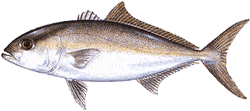
Olive green or brownish back and silver sides; dark band (variably present) extends backward and upward from eye; juveniles have split or wavy bars on sides; proportionately larger eye and deeper body than Greater Amberjack.
Where Found:
NEARSHORE and OFFSHORE, apparently living deeper than other Seriola (commonly 180-410 feet deep).
Size:
Usually under 10 pounds.
Remarks:
Smallest of the Amberjacks; believed to spawn offshore; adults eat fish, and squid.
Longbill Spearfish

Color of body dark blue, shading to silvery, white underneath; dorsal fin bluish, others brown-black; two dorsal fins, the first lengthy, its front forming a peak; two anal fins, the anus well in front of the first; upper jaw prolonged into spear, its cross section round.
Where Found:
OFFSHORE in deep water.
Size:
Relatively small species. Largest caught approximately 61 pounds.
Remarks:
Uncommon; available data indicate that the spearfish matures at 2 years of age, and rarely lives past 4 to 5 years; they are pelagic, and feed at or near the surface, mainly on fish and squid.



